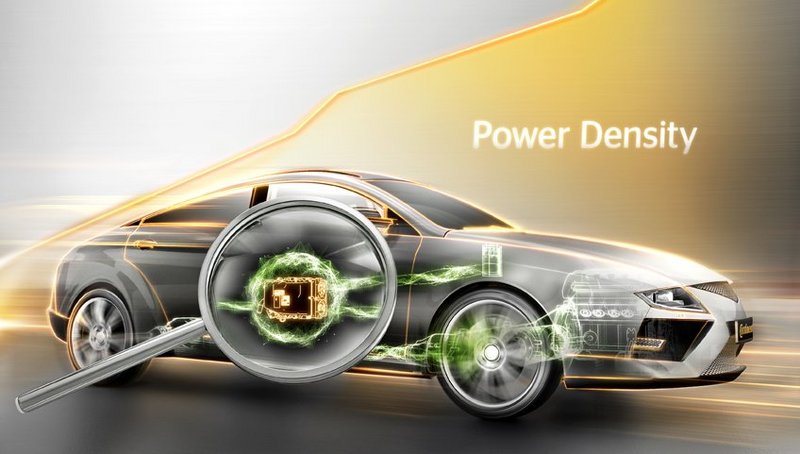Key Component in the Electric Drive: Award-Winning Continental Power Electronics Further Optimized
- The new generation of more compact power electronics, which will be launched in August 2015, controls the power of hybrid and electric vehicles even more efficiently.
- The system is of central importance for the electric drive's power, and makes it fun to drive
- Modular and scalable concept: the Continental system is used in nearly all vehicle segments
- Audi Quality Award for Budapest production site
Regensburg, April 21, 2015. When it comes to hybrid and electric vehicles, there appear to be many seemingly straightforward general assumptions. The range of the electric drive is determined by the battery; its acceleration characteristics by the electric motor. Yet in both cases, there is another decisive factor: the efficiency of the entire electric drive system – and this is determined primarily by the power electronics. This electronic system, which controls both the power as well as the energy recovery (recuperation), has a major influence here. It is also responsible for fully utilizing the potential of the electric drive, thereby making it fun to drive, which is caused in part by the high starting torque and the response behavior of electric motors. Continental, international automotive supplier and innovation driver in e-mobility for over ten years, is already producing the second generation of power electronics for five European automotive manufacturers. And now, the next generation is ready to be launched. This system, which is even more compact and even more powerful, will enter series production in August 2015.
"The currently slightly muted euphoria regarding electro mobility will not prevent electrified drives from playing an important role on the automotive market in the long term. Because relying purely on combustion engines, it is becoming increasingly difficult to comply with the ever stricter guidelines, which are in force around the world. By 2020 alone, these guidelines demand reductions in fuel consumption and CO2 emissions ranging from 20 to 35 percent," says Dr. Bernd Mahr, Head of the Hybrid Electric Vehicle Business Unit, which belongs to the Continental Powertrain Division. "Regarding electrified drives, we will see a stronger focus on two market sectors in the future. One of these is plug-in hybrid vehicles, because they can be driven purely on electricity on a daily basis without placing restrictions on the range of car journeys. The second field is vehicles with hybrid systems based on 48 V. Because this new technology can be integrated very easily into the architecture of conventionally powered vehicles and leads to considerable fuel savings – and the costs remain acceptable." Continental is going to launch its "48 Volt Eco Drive" system on the market as early as 2016.
Third generation with six times the power and a reduced weight
"In addition to the functionality and efficiency of the power electronics, the space requirements and weight are important criteria for automotive manufacturers. This is why we are constantly working on further increasing our system's power to size ratio," says Axel Weber, Head of Power Electronics Development in the Hybrid Electric Vehicle Business Unit. "The third generation of our power electronics is six times more powerful than the first generation. This means that it can operate an engine six times as powerful. The system's weight has also been reduced from around 12 kg originally to around 8 kg today." He also states that the costs in relation to power (price per kW) have also decreased considerably and the development time has been shortened. By contrast, the range of application has become even broader. "The new system generation will enter series production in the summer in plug-in hybrids. But it can also be used in all-electric vehicles as well as in all vehicle segments right up to powerful sports cars," says Weber. And other Continental systems are also set to benefit from the further increase in expertise regarding e-mobility. "Our '48 Volt Eco Drive' is largely based on experience gained in the development of power electronics. And naturally, our latest findings and innovations will be incorporated into the 48-V technology." The Continental expert also appears in a new video that illustrates the function of the power electronics and explains the innovations of the third generation.
Control center between electric motor, battery, and 12-V on-board power supply
Continental's power electronics is designed as a modular and scalable system, and is used in a wide range of vehicles from the mild hybrid right up to the electric car, from the small car up to the luxury sedan. The system is a key component in every electrified drive, as it supplies both the electric motor as well as the high-volt battery with electricity – when the electric motor works as a generator and feeds electricity into the battery (recuperation). For functional reasons, the power electronics is therefore positioned between the high-volt battery and electric motor, regardless of where the control unit is installed in the vehicle.
The battery supplies the electrical energy as direct current, but the electric motor needs a three-phase alternating current. The power electronics converts the electricity accordingly, and guides it towards the engine in the required amperage and frequency; the engine is controlled by means of these parameters. Without the power electronics, the reverse procedure would not be possible. During recuperation, the power electronics converts the alternating current generated by the electric motor into direct current, and thus charges the battery. The power electronics is also responsible for supplying the 12 V on-board power supply of the hybrid and electric vehicles with power. The energy exchange between the high-volt grid (up to 450 V depending on the system) and the 12 V grid is guaranteed by a DC/DC converter, which also makes the traditional dynamo redundant. Another function of the power electronics is that it enables reverse driving by reversing the polarity and thus changing the electric motor's direction of rotation. The two central components in the power electronics are the inverter and the DC converter. An important factor in the success of the Continental system is the innovative inverter, which enables a high number of cycles and makes a significant contribution to the efficiency of this power electronics. The DC/DC converter is also highly efficient, as it converts the voltage almost loss-free. Another special feature of the Continental system is that both components are integrated into a housing, and this makes the power electronics extremely compact.
Headquarters of Hybrid Electric Vehicle in Nuremberg, quality award from Audi for Budapest site
The Continental Hybrid Electric Vehicle Business Unit is in charge of all core elements of the electric drive: power electronics, electric motors, and battery management. It has its headquarters in Nuremberg, where it operates a state-of-the-art test and development center for power electronics. This electronic has been produced at the Nuremberg site for a long time now. The Business Unit has also been developing and producing the systems at the Continental site in Budapest since 2011. This second power electronics plant of Continental recently received a high award from a German premium manufacturer: the Audi Quality Award "Prevention & Reliability 2014."
Continental is a technology leader in the field of electro mobility, and has proven its wide-ranging expertise in this area by means of many innovations, including the first serial hybrid system in Europe (2003) and the world's first separately excited synchronous motor without rare earths (2011). In addition, the widely-established automotive supplier with its different divisions meets all requirements placed on vehicles with an electrified drive from a single source: from integration, energy optimization, and drive management, right up to vehicle safety, information management, and energy-saving tires.

Simone Geldhäuser
Head of Media Relations, Spokesperson Finance, Business and Technology
Vitesco Technologies
